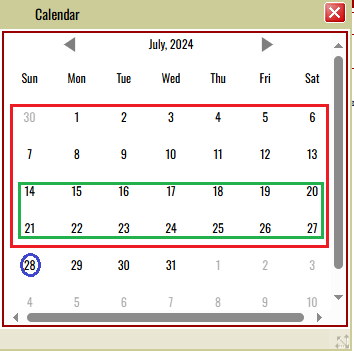KOM Informatics: Raising 20 Minute Power Over 4 Weeks vs 2 Weeks: What Actually Worked
By David Brown
 The KOMInformatics.com SysAdmin has the ability to run a Training Effectiveness Report for a given time frame, workload window, and offset for each eligible user.
The report extracts statistically significant relationships between performance and workload using PR watts on the performance
side against kilojoules of work on the workload side. The SysAdmin specifies 4 parameters for the report.
The time frame specifies the date range of the rides for the analysis. The workload window
uses the date of each PR as a starting point looks at a block of training starting x number of days in back of
the PR (offset) and extending x number of days further back in time from the offset point (duration). The last parameter is the number of PRs. For background
info on the report and these concepts see the first article in this series KOM Informatics: Raising 20 Minute Power Over 4 Weeks: What Actually Worked.
The KOMInformatics.com SysAdmin has the ability to run a Training Effectiveness Report for a given time frame, workload window, and offset for each eligible user.
The report extracts statistically significant relationships between performance and workload using PR watts on the performance
side against kilojoules of work on the workload side. The SysAdmin specifies 4 parameters for the report.
The time frame specifies the date range of the rides for the analysis. The workload window
uses the date of each PR as a starting point looks at a block of training starting x number of days in back of
the PR (offset) and extending x number of days further back in time from the offset point (duration). The last parameter is the number of PRs. For background
info on the report and these concepts see the first article in this series KOM Informatics: Raising 20 Minute Power Over 4 Weeks: What Actually Worked.
Up until recently the Training Effectiveness report included data on 6 month time frames (Jan-Jun, July-Dec) from 2022/2023 based on 0 offset and a 28 day workload window. This time frame data was expanded to include 0 offset and a 14 day workload window. I thought it would be interesting to compare and contrast the 2 datasets. A visual representation of a workload window with respect to a single PR is in the image below. The 14 day window (green) is a subset of the 28 day window (red), residing closer to the date of the PR (blue). All the datasets used 5 for the number of PRs.

Training Effectiveness Report Results (2022-2023)
As of 8/7/2024, The admin controlled Training Effectiveness report has run 9 times reporting on 6 month time frames (Jan-June, Jul-Dec) for 2022 and 2023. Five of those times the report used 28 days for the workload window, 0 days for the offset and 5 for the number of PRs. 28 days was thought to be a reasonable amount of time for most interventions to start showing some results. The data from the last time the 28 day window was run (Jan-June 2024) is not included in this analysis which is limited to 2022-2023. There are some minor differences in the 28 day day data compared to to the results published in the first article in this series due to new users backfilling data from 2022-2023. The other four runs used 14 days for the workload window, 0 days for the offset and 5 for the number of PRs. Requiring 5 PRs runs the risk of losing some significant results had the number been set lower, but has the benefit of more firmly establishing a trend.
28 Day Workload Window: Percentage of Users Attaining Statistically Significant Results
19% of KOM Informatics users were able to achieve significant results at least once over 2 years. 8.8% of users registered more than 1 significant result. Overall, these users achieved an average gain of 23 watts from the lowest to highest PR. Those users with more than one significant result achieved an average gain of 23.75 watts.
14 Day Workload Window: Percentage of Users Attaining Statistically Significant Results
28% of KOM Informatics users were able to achieve significant results at least once over 2 years. 13.92% of users registered more than 1 significant result. Overall, these users achieved an average gain of 20 watts from the lowest to highest PR. Those users with more than one significant result achieved an average gain of 22.75 watts.
28 Day Workload Window: Breakdown of Statistically Significant Results by Workload Type
Workloads for Z3,Z4,Z5,Z6 and Z7 all involved interval efforts. NI stands for non-interval. Aerobic intervals (Z4, Z5) dominated the successful interventions, accounting for 52% combined, but the average watt gains (Z4 22, Z5 20) were a little lower than Anaerobic (Z6 26, Z7 28) and NI (28). Anaerobic workloads (Z6, Z6) accounted for a not insignificant 30% which probably reflects the popularity of HIIT modalities.
| 28 Day Workload Window | |||
| Workload | Intervention % | Average Watts Gain | Average R |
| NI | 15% | 28 | 0.843475 |
| Z3 | 4% | 6 | 0.8078 |
| Z4 | 26% | 22 | 0.864457142857143 |
| Z5 | 26% | 20 | 0.828585714285714 |
| Z6 | 11% | 26 | 0.8622 |
| Z7 | 19% | 28 | 0.86652 |
14 Day Workload Window: Breakdown of Statistically Significant Results by Workload Type
Workloads for Z3,Z4,Z5,Z6 and Z7 all involved interval efforts. NI stands for non-interval. In contrast to 28 day workload windows, the 14 day windows were dominated by anaerobic intervals (Z6, Z7) which together accounted for 46% of the successful interventions, but the average watt gains (Z6 19, Z7, 14) were less than aerobic intervals (Z4 25, Z5 28) and NI 24 .
| 14 Day Workload Window | |||
| Workload | Intervention % | Average Watts Gain | Average R |
| NI | 18% | 24 | 0.872257142857143 |
| Z3 | 8% | 12 | 0.849966666666667 |
| Z4 | 15% | 25 | 0.88585 |
| Z5 | 13% | 28 | 0.8614 |
| Z6 | 23% | 19 | 0.869644444444444 |
| Z7 | 23% | 14 | 0.906122222222222 |
How well did 28 day interventions persist over the last 14 days?
Interventions from the 28 day set were matched against interventions from the 14 day set on UserId, TimeFrame and Workload. Only 18.5% of the 28 day interventions were found in the 14 day interventions with an Average Watts Gain of 19.2. The 81.5% of the 28 day interventions not found in the 14 day interventions had an Average Watts Gain of 24.59.
Effect of multiple successful interventions spanning both datasets
A number of athletes achieved successful interventions in both the 28 day and 14 day datasets for the same timeframe, for an average watts gain of 22. The greatest watts gain (69) was achieved by an athlete with a successful 28 day intervention involving non-interval workloads, coupled with 2 successful 14 day interventions (Z5, Z6). The second greatest watts gain (25) was achieved by an athlete that had 4 successful 28 day interventions (Z4, Z5, Z6, Z7) coupled with 2 14 day interventions (Z5, Z7)
Discussion
Clearly it's easier to attain successful interventions @14 days (28% success rate) vs @28 days (19% success rate). Part of this discrepancy can be explained by the recency principle which suggests that more recent workouts have a greater impact on current fitness level compared to older workouts. Another common sense reason might be that athletes are encountering life events and bad weather conditions that make it difficult to achieve progressive overload over the course of 4 weeks which may not be as prevalent at 2 weeks.
The shift in success prevalence from 28 days (aerobic intervals) to 14 days (anaerobic intervals) supports the widely held view that aerobic adaptations take somewhat longer to be fully realized compared to anaerobic adaptations. However those that had successful aerobic interventions (Z4,Z5) @14 days enjoyed a higher watts gain (Z4 25,Z5 28) than anaerobic interventions (Z6 19, z7 14).
Those athletes that achieved multiple successful interventions within the same dataset enjoyed a small (3.2% 28 days) and/or a significant(13.75% 14 days) advantage in watts gain over those that only had a single successful intervention. Since watts gains are difficult to come by, especially in well-trained athletes, setting up a program that provides progressive overload in more than 1 area would seem to be a good strategy.
Since there aren't that many adaptations, and there is significant overlap in how adaptations accrue as a result of training in different zones. selecting the initial modality to raise 20 minute power comes down to individual preference. A workout that a rider will perform will create more adaptations than one they won't. However, progress needs to be continually tested at regular intervals, and monitored with a tool like the PR/Workload Correlation Report to ensure an intervention is still delivering benefits. When it's doesn't, the data supports a shift in strategy employing different modalities to ensure further progress.